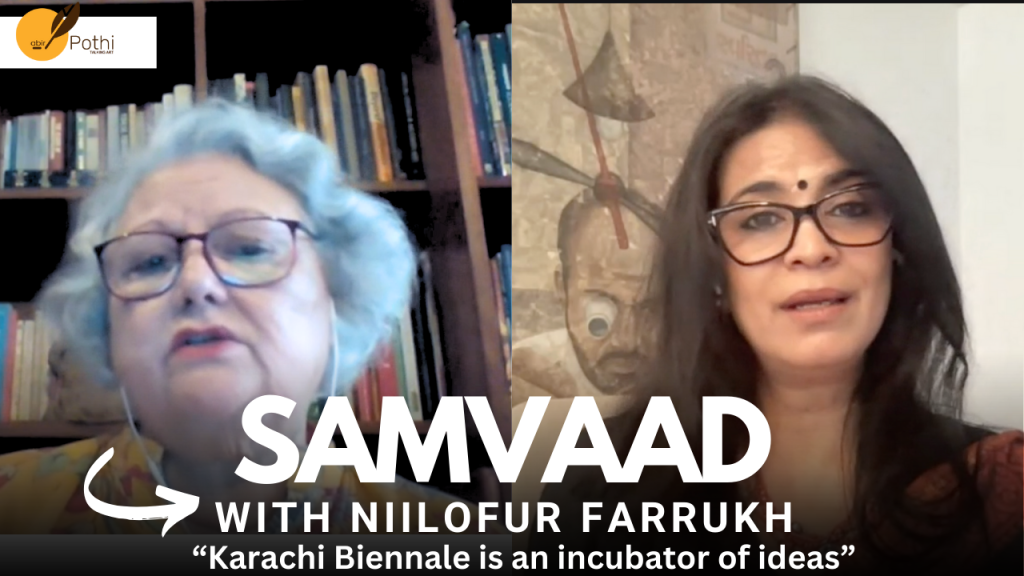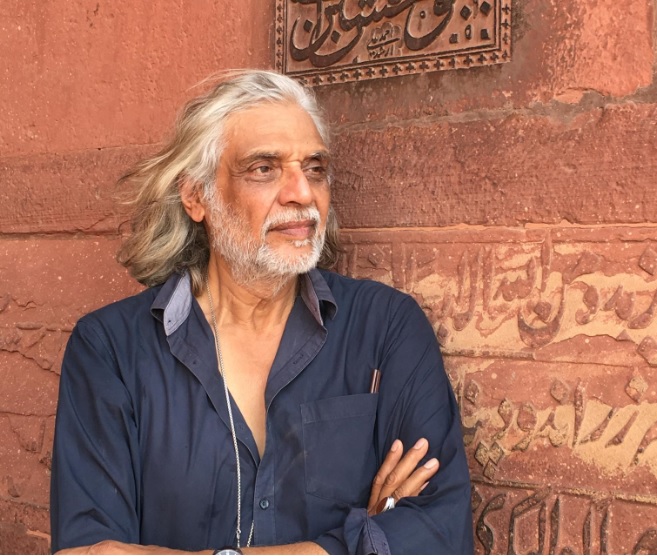Welcome to Samvaad, where art meets conversation, and inspiration knows no bounds. Here we engage in insightful conversations with eminent personalities from the art fraternity. Through Samvaad, Abir Pothi aims to create a platform for thought-provoking discussions, providing readers with an exclusive glimpse into the creative processes, inspirations, and experiences of these creative individuals. From curating groundbreaking exhibitions to pushing the boundaries of artistic expression, our interviews shed light on the diverse perspectives and contributions of these art luminaries. Samvaad is your ticket to connect with the visionaries who breathe life into the art world, offering unique insights and behind-the-scenes glimpses into their fascinating journeys.
Introduction
The Samvaad between notable Karachi-based art interventionist Niilofur Farrukh and Abir Pothi’s Ruby Jagrut delves into the twin narratives of the neighbouring nations’ art histories, evolution and contemporary scenarios — both formed in the same crucible and yet inimitably diverse. The managing trustee of the Karachi Biennale Trust, Farrukh highlights her in-depth views on public art, regional art, and the place of decolonisation in the artistic zeitgeist. Farrukh also brings to the discussion her perspective from extensive experience of decades in the field of art, her research and literary prowess, academic heft as an art historian, critic and curator, and anecdotes from travels in the pursuit of art. Her insight into the work of art stalwarts is an exercise in learning.
Besides serving as CEO of the Karachi Biennale, Farrukh has contributed as the Pakistan Commissioner at Tashkent Biennale, Asian Art Biennale and Kathmandu International Art Festival. She co-founded ASNA and co-curated four iterations of ASNA Clay Triennials, the longest running Triennial in the country. She is the President of AICA Pakistan and has served on the International Board of the International Art Critics Association. Farrukh has written extensively for national and international publications, and has been a longtime advocate for an interface between art and public audiences, curating outstanding exhibitions.

The conversation between Ruby Jagrut and Niilofur Farrukh provides a fascinating insight into the inception and evolution of the Karachi Biennale, as well as the overarching themes and challenges faced in the area of contemporary art. Niilofur Farrukh’s role as an art historian, critic, curator, and activist is underscored by her commitment to addressing issues of decolonisation and fostering inclusive social dialogue through art in public spaces.
Karachi Biennale: Inception, Evolution, and Local Anchoring
The genesis of the Karachi Biennale is traced back to the desire to showcase the work of Pakistani artists who were participating in major biennales worldwide. The first edition in 2017 was not only a platform for artistic expression but also a response to the prevailing violence and divisive politics in Karachi. The belief in the healing power of art and its ability to bring people together became a driving force for the biennale’s establishment.
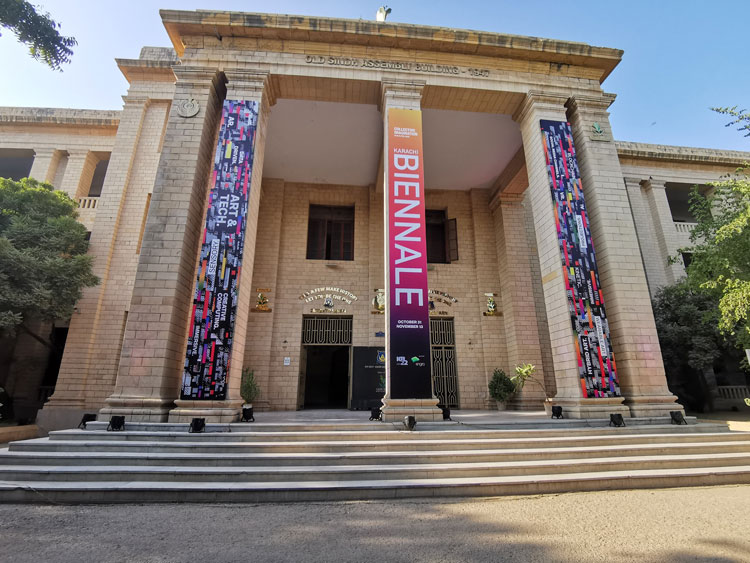
As the Karachi Biennale prepares for its fourth edition, Niilofur Farrukh emphasises the importance of anchoring each event in the local context of Karachi. The chosen themes reflect the societal and environmental challenges faced by the region, initiating a connection between local and global perspectives. The upcoming edition will focus on the “foodscape” and explore the impact of colonisation on the access, production, and commodification of food. This theme not only addresses contemporary issues like food security but also delves into the political and historical dimensions of food.
Curatorial Process and Themes: Bridging Local and Global Perspectives
The interview sheds light on the curatorial process, with Niilofur Farrukh explaining that the framework is created, and artists are given the freedom to explore and interpret the theme. The diversity and complexity of the chosen topic make it an intriguing challenge for artists, promising a rich and varied artistic exploration. She also announces the introduction of the first woman curator, Waheeda Bano Baloch, for the upcoming edition. This decision reflects a commitment to diversity and fresh perspectives within the curatorial team.
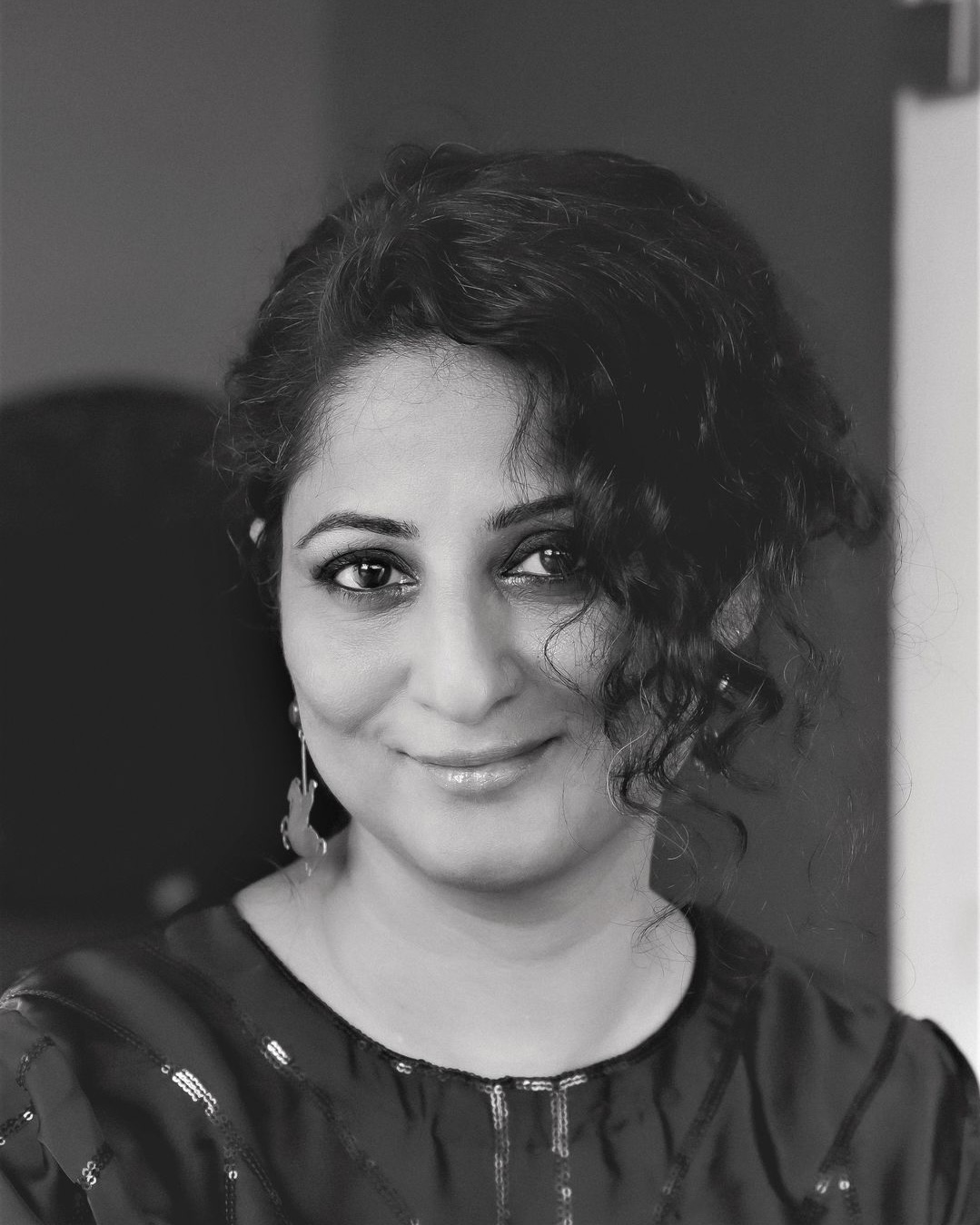
Innovation and Inclusivity at Karachi Biennale
Niilofur Farrukh emphasised that the Karachi Biennale serves as an incubator for innovative ideas, providing artists with a platform to experiment with cutting-edge genres such as sound art, performance art, and technology. The event encourages international collaborations, welcoming artists like Solimán López from Spain and a sound artist from the UK who worked with local musicians, bridging technology with Pakistan’s rich cultural history.
Addressing the question of local inclusion, Farrukh highlighted the organic connections formed between artists and local craftsmen, musicians, and performers. The biennale actively encourages such collaborations, allowing artists to experiment and showcase their work. Farrukh cited an example of a group transforming the traditional Chitrali sitar into a mechanised, robotic form during the last biennale.
Challenges and Contributions in the Pakistani Art Scene
Contemporary artists in Pakistan face a dynamic landscape with both challenges and opportunities. One evident challenge lies in the limited infrastructure, notably the absence of a dedicated art museum in Karachi. The need to utilise improvised spaces, including parts of universities and heritage sites, underscores the struggle for suitable exhibition venues. The artists from smaller towns may grapple with limited exposure, emphasising the importance of platforms like Art Fest to showcase their work. However, amidst these challenges, there are numerous opportunities for artists to thrive. Various forums, such as galleries with frequent openings and the Karachi Biennale, provide diverse platforms for exhibition.
The mention of online activity signifies the potential for artists to leverage digital platforms, reflecting a global trend in art promotion. The interconnectedness of different forums and the support of a vibrant artistic community imply that artists in Pakistan can navigate and overcome challenges through resourcefulness, ultimately contributing to a healthy and robust art scene in the country. Farrukh acknowledged the challenges faced by contemporary artists in Pakistan and highlighted other platforms like regional exhibitions, Art Fest, and active galleries. The Karachi Biennale, with its nine venues across the city, stands out as a significant contributor, producing a large body of work and providing a unique scale of interaction for artists.
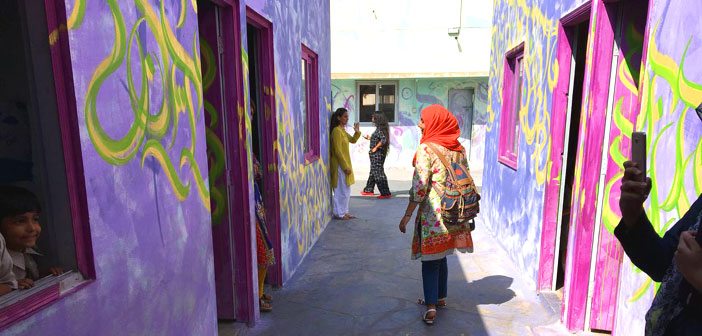
Responding to inquiries about international participation, Farrukh expressed a preference for regional artists while noting collaborations with artists from Sri Lanka, Bangladesh, Nepal, Iran, the UAE, and, potentially, India. The biennale aims to facilitate a neutral and engaging dialogue by including artists from various continents, fostering cross-cultural exchange and addressing global issues through art.
Public Engagement and the Significance of Public Art
Niilofur Farrukh highlighted how the general public’s enjoyment of art is underestimated, using Pakistan’s rich cultural heritage and historical artwork as examples. Through broad educational programmes, the Karachi Biennale actively engages a variety of audiences, including students. Building a relationship between society and the art community, addressing contemporary challenges, and conceptual concepts are stressed. Art is also emphasised as a language.
Addressing the challenges of retaining cultural essence amid globalisation, Niilofur Farrukh discussed the significance of public art in Pakistan. The city’s unique landscapes, including gardens and chaurahas, serve as spaces for people to engage with art. She highlighted the Karachi Biennale’s contribution to public art, where large installations are displayed in public parks and some artworks are gifted to the city, becoming permanent fixtures for continued public exposure.
Tracing the Evolution of Truck Art and Insights into Ustad Allah Bakhsh
The conversation delved into the organic nature of Pakistan’s famous truck art, tracing its evolution over the years. Niilofur Farrukh explained how this form of art reflects the current news and sentiments, capturing a unique moment in history. Truck art serves as an expressive narrative, connecting with the people on the move.

Expressing her desire to attend the Kochi Biennale and acknowledging the challenges of global connectivity, Niilofur Farrukh shared her thoughts on the Karachi Biennale’s efforts to include regional and international artists. The event aims to create a dialogue that transcends borders, fostering cross-cultural exchange and addressing global issues through diverse artistic expressions.
Niilofur Farrukh highlighted influential artists such as Sadequain, Shakir Ali, and Zahoor ul Akhlaq. Sadequain’s public art murals, Shakir Ali’s impact on art academia, and Zahoor ul Akhlaq’s role in bridging Modernism and Post-Modernism were emphasised in response to a question about the most significant art movement post-independence. The discussion also touched upon the contemporary significance of artists like Imran Qureshi, Rashid Rana, and Meher Afroz, whose work reflects a fusion of cultural experiences. She also provided insights into her research on Ustad Allah Bakhsh, shedding light on the artist’s significance and contemporary resonance. Farrukh, a key figure in shaping the discourse on Pakistani art, delved into the enigmatic world of Ustad Allah Bakhsh’s paintings and their relevance in the context of contemporary art.

Ustad Allah Bakhsh, a contemporary of M.A. Rahman Chughtai, has often been overshadowed in art discourse. Farrukh, however, emphasised the artist’s distinctiveness, especially through his intriguing rock paintings. These unique artworks, focused solely on rock formations, captivated Farrukh’s attention due to their modern sensibility, resembling abstract paintings.
During her research, Farrukh discovered Ustad Allah Bakhsh’s unconventional approach to art. Notably, the artist did not date his works, making the chronology discernible only through stylistic analysis. Farrukh highlighted Ustad Allah Bakhsh’s fluidity in style, a characteristic uncommon for artists of his time.

What emerged from Farrukh’s exploration was the revelation that Ustad Allah Bakhsh possessed a remarkably contemporary sensibility. His career spanned diverse experiences, including work in Calcutta during the 1920s and 1930s, contributing to Agha Hashar Kashmiri’s theatre company. Later, he ventured into Bombay, working in the film industry and gaining exposure to various artistic influences.
Farrukh pointed out Ustad Allah Bakhsh’s keen awareness of choreographing groups and spatial relationships in his paintings, a trait reflecting his exposure to the new Bengal School of Art’s wash-painting. The artist’s experimentation with sensitive surfaces and lush textiles, inspired by Raja Ravi Varma, showcased his ability to assimilate contemporary trends into his practice. Interestingly, Ustad Allah Bakhsh’s openness to diverse influences was evident in his early Krishna paintings, earning him the moniker of the “Krishna painter.” It was only later in his career, upon settling in Lahore, that he delved into Punjabi folklore and rural scenes.
Farrukh concluded that Ustad Allah Bakhsh’s adventurous and courageous spirit, coupled with his assimilative approach to cultural influences, positioned him as a truly contemporary artist. The upcoming publication promises to unveil more aspects of this lesser-known artist’s legacy, offering a fresh perspective on his contributions to the rich tapestry of Indian cultural art.
Farrukh, known for her pivotal role in shaping the discourse on Pakistani art, expressed her desire to meet and engage with Indian artists, citing Subodh Gupta, Jogen Chowdhury, Nalini Malani, and Arpana Caur as individuals she would love to connect with. Emphasising the importance of cultural exchange, she envisioned hosting Indian artists in Pakistan, facilitating a reciprocal sharing of artistic insights and experiences.
Cross-Border Connections and Future Plans
Looking ahead, Farrukh outlined her future plans, emphasising the role of art as a powerful form of dialogue. She stressed the need for continued exchange between Indian and Pakistani artists, historians, and institutions. Farrukh envisioned a deeper integration of decolonisation in art education, advocating for its central role rather than being treated as a fringe subject.
As part of her future projects, Farrukh expressed her commitment to completing her research on the art history of Karachi and consolidating her extensive writings. She underscored the importance of telling the region’s story without external mediation, asserting the need for self-directed narratives rooted in the shared history and reality of the subcontinent.
Towards Cross-Border Art Dialogue: Mutual Gratitude and Collaboration
Ruby Jagrut, representing Abir Pothi, expressed gratitude for Farrukh’s insights and suggested the possibility of establishing a seminar series to further the cross-border art dialogue. Farrukh welcomed the idea, envisioning a positive collaboration that could bring together artists, historians, and art enthusiasts from both countries.
At the end of the discussion, there was mutual gratitude and an agreement to promote further exchanges, which might include the Karachi Biennale in the future. The conversation between Farrukh and Jagrut is a positive start towards fostering cross-border ties and a common love of art and cultural heritage within the South Asian art diaspora.
Breaking Ground: Waheeda Baloch as the First Woman Curator of Karachi Biennale KB24

